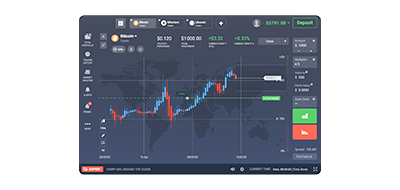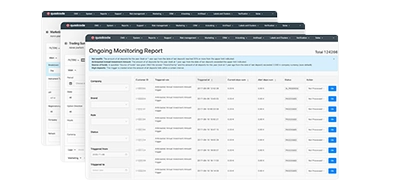Back

Crypto Exchange
Step-by-Step Crypto Exchange Development Guide

Written by:
Vitaly Makarenko
read
Published:
March 15, 2024Updated:
May 3, 2024views
Table of contents
As the crypto industry continues to explode in popularity and value, launching their own crypto exchange platform has undoubtedly popped into the hearts of many budding entrepreneurs and tech visionaries. These platforms serve as the backbone of the blockchain economy, connecting buyers and sellers of digital currencies while also facilitating trades of emerging cryptos and blockchain projects.
Owning an exchange sounds like an exciting way to get involved in this booming sector while also building a lucrative business. However, it’s not an endeavor to take lightly — building a reputable and compliant exchange that can compete in today’s market requires careful planning, healthy budgets, and technical expertise. But it’s certainly not impossible either if you do your homework and follow a structured development process.
In this article, we’ll break down the comprehensive steps needed to conceptualize, design, and launch your own crypto exchange from the ground up—consider it your ultimate guide to entering this competitive industry and establishing your mark. By the end, you’ll gain a solid understanding of what it takes and have a clear roadmap to get your vision off the ground.
What Is a Cryptocurrency Exchange?
Cryptocurrency exchanges serve as a marketplace where people can trade cryptocurrencies for other currencies, digital assets, and/or fiat. They play an important role in the digital asset world by connecting buyers and sellers. Exchanges make it possible to exchange things like Bitcoin for dollars or Ether easily.
Without exchanges, it would be much harder for people to buy, sell, and trade cryptocurrencies. With exchanges, however, the crypto market has more liquidity to tap into, making it more accessible to users. They also allow value to flow in and out of different digital currencies, which helps cryptocurrencies gain more widespread use and adoption.
Crypto exchanges are more than just platforms to facilitate trades; they offer different investment options to help people grow their money in crypto. They offer services like margin trading, futures trading, and staking that let users take a more active approach if they want to. Exchanges also provide tools like live pricing data so traders can make educated conclusions.
At its core, any reputable crypto exchange aims to provide a secure and user-friendly platform. They want to make it simple for buyers and sellers to connect in one centralized place. The goal is to let people easily trade digital currencies through a safe, reliable system.
In essence, they underpin the whole crypto economy. They bridge traditional finance into this new digital realm. By providing decentralized exchange alternatives, they work towards greater democratization of money worldwide. Exchanges truly are the backbone of how cryptocurrencies function and gain broader adoption.
Key Aspects of Cryptocurrency Exchanges
- Trading pairs: Exchanges promote the trading of different cryptocurrency pairs. For example, Bitcoin to Ethereum or Litecoin to USD. This allows users to exchange one coin for another easily.
- Order book: The exchange also maintains an order book that lists all open buy and sell orders placed by users. When matching orders are placed, a trade occurs.
- Wallets: Users must store their digital currencies and fiat funds on the exchange via integrated crypto wallets until needed for trades. These wallets facilitate deposits, withdrawals, and transactions.
- Security: Reputable exchanges implement robust security features like cryptocurrency cold storage, bank-grade encryption, multi-factor authentication, and more to protect user funds and data.
- Fees: Most exchanges make money by charging trading fees on each transaction. These are usually a percentage of the trade value.
What Are The Types Of Crypto Exchanges?
It is quite important for both developers and users to understand the diverse landscape of cryptocurrency exchanges. Each type of exchange offers a unique set of features, benefits, and considerations. Here are the various types of exchanges, their characteristics, advantages, and potential drawbacks.
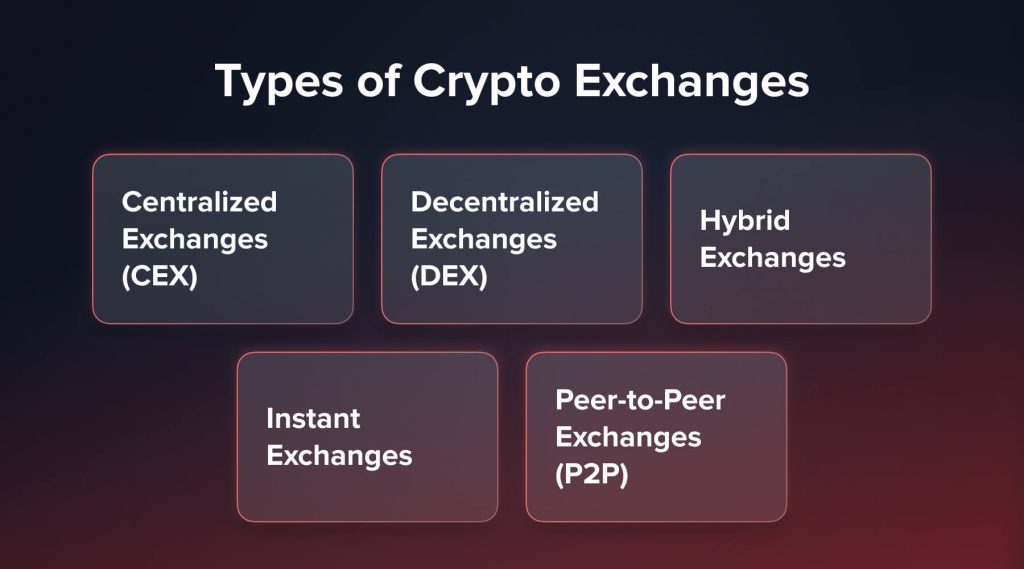
1. Centralized Exchanges (CEX)
Centralized Exchanges (CEX) are the most familiar type of cryptocurrency exchanges, operating under a centralized authority that oversees and facilitates all transactions. Common examples include Coinbase, Binance, and Kraken. Such outlets offer a user-friendly interface, high liquidity, and a wide range of supported cryptocurrencies and trading pairs.
Advantages:
- User-Friendly: Centralized exchanges are known for their intuitive interfaces, making them accessible to both novice and experienced traders.
- High Liquidity: The large user base contributes to increased trading volumes, ensuring liquidity and enabling users to execute trades efficiently.
- Advanced Features: Many CEXs offer advanced trading features, such as margin trading, futures, and derivatives, catering to diverse trading strategies.
Drawbacks:
- Security Concerns: Being centralized, these exchanges are susceptible to hacking and security breaches, necessitating robust security measures.
- Regulatory Compliance: CEXs are subject to regulatory scrutiny and must comply with local and international regulations, which may impact their operations.
2. Decentralized Exchanges (DEX)
Decentralized Exchanges (DEX) operate without a central authority, enabling peer-to-peer trading of cryptocurrencies. Platforms like Uniswap, SushiSwap, and PancakeSwap are prominent examples. DEXs leverage smart contracts and blockchain technology to automate and secure transactions, eliminating the need for intermediaries.
Advantages:
- Enhanced Security: The decentralized nature reduces the risk of hacking and central points of failure, providing users with greater security.
- Censorship Resistance: DEXs are less susceptible to regulatory interventions and censorship, offering a truly decentralized trading experience.
- Privacy and Control: Users retain control over their private keys and personal information, enhancing privacy and security.
Drawbacks:
- Usability: Some users may find DEXs less intuitive and user-friendly compared to their centralized counterparts.
- Lower Liquidity: DEXs may experience lower trading volumes and liquidity, impacting the efficiency of trade execution.
3. Hybrid Exchanges
Hybrid exchanges aim to combine the best of both centralized and decentralized exchanges. They seek to offer the user-friendliness and liquidity of CEXs while maintaining the security and decentralization of DEXs. Examples of hybrid exchanges are less prevalent but represent an innovative approach to cryptocurrency trading.
Advantages:
- Balanced Approach: Hybrid exchanges offer a balanced trading experience, combining the benefits of both CEXs and DEXs.
- Enhanced Security: By incorporating decentralized elements, hybrid exchanges strengthen security and reduce the risk of hacks.
- Diverse Trading Options: Users can access a wide range of trading options and features, catering to various trading preferences.
Drawbacks:
- Complexity: Integrating centralized and decentralized elements can increase complexity and a steeper user learning curve.
- Emerging Model: As a relatively new model, hybrid exchanges are still evolving, and their effectiveness and reliability are yet to be fully proven.
4. Instant Exchanges
Instant exchanges are designed to provide users with a quick and seamless experience for exchanging cryptocurrencies. Platforms like Changelly and ShapeShift are notable examples of instant exchanges. These exchanges do not hold customer funds, distinguishing them from traditional exchanges, and instead facilitate immediate swaps between different cryptocurrencies.
Advantages:
- Speed: Instant exchanges are known for their rapid transaction processing, allowing users to swap cryptocurrencies swiftly without the need to deposit funds on the platform.
- Convenience: The user interface is typically straightforward and easy to navigate, making it accessible for users of all experience levels.
- Diverse Cryptocurrency Support: These exchanges often support a wide range of cryptocurrencies, providing users with multiple options for trading.
Drawbacks:
- Higher Fees: Instant exchanges may charge higher fees than other exchanges due to their convenience and speed.
- Price Slippage: Due to the immediate nature of transactions, users might experience price slippage, especially in volatile market conditions.
5. Peer-to-Peer Exchanges (P2P)
Peer-to-peer exchanges, also known as P2P exchanges, facilitate direct transactions between buyers and sellers without the need for an intermediary. LocalBitcoins and Paxful are well-known P2P exchanges. These platforms often use an escrow service to hold the assets until both parties fulfill their obligations, thereby ensuring the integrity of the transaction.
Advantages:
- Direct Transactions: P2P exchanges allow users to transact directly with each other, offering a more personalized trading experience.
- Enhanced Security: The use of escrow services and smart contracts enhances the security of transactions by ensuring that assets are released only when both parties meet the agreed terms.
- Flexible Payment Methods: Users can choose from a variety of payment methods, including bank transfers, cash payments, and digital wallets, making transactions more accessible and convenient.
Drawbacks:
- Lower Liquidity: P2P exchanges may have lower liquidity than centralized and decentralized exchanges, which can affect the availability of trading pairs and impact prices.
- Varied User Experience: The user experience can vary significantly based on the counterparties involved in the transaction, and dispute resolution may be challenging in case of disagreements.
Step-by-Step Guide on Setting Up Your Crypto Exchange
To launch a successful cryptocurrency exchange requires meticulous planning and execution. With a structured process, you can develop a platform that attracts significant user adoption and grows into a sustainable business. The steps below can help you create a platform that attracts users and becomes a real business.
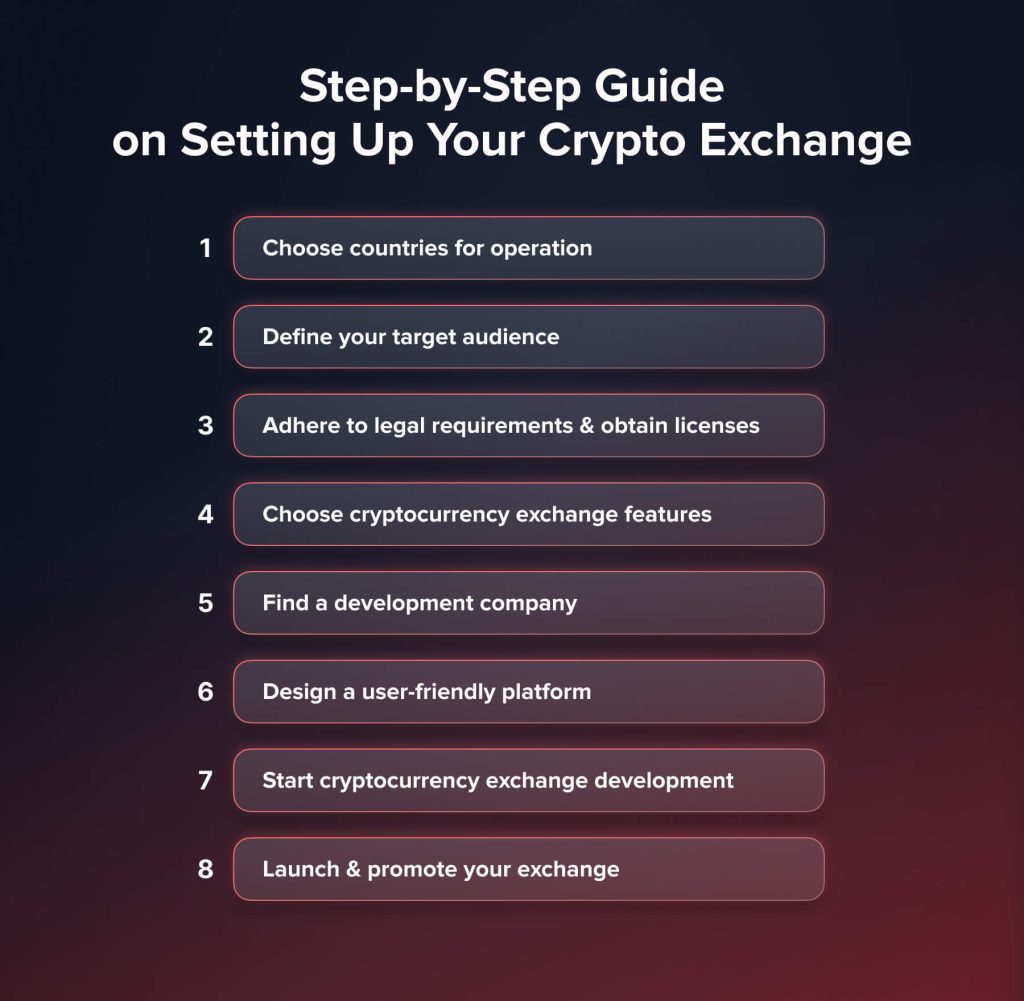
1. Choose countries for operation.
The first major decision is determining where you will operate your exchange. Start by considering your local market regulations—research which countries have the largest crypto audiences and friendliest stances towards the industry. Operating locally first allows a better understanding of the landscape before expanding globally.
2. Define your target audience.
Engage crypto communities on social media and forums to understand the needs and behaviors of potential users. Identify which demographics actively trade digital assets—target early adopters seeking additional exchange options.
3. Adhere to legal requirements & obtain licenses.
Seek legal counsel to ensure compliance with all applicable regulations in your chosen jurisdictions. Regulations around KYC/AML, taxation, and restricted activities vary substantially between countries. Acquiring the proper licenses legitimizes your business and provides users confidence.
4. Choose cryptocurrency exchange features.
Integrate essentials like user registration/verification systems, e-wallets, order books, and advanced charting tools. Consider what extra functionality established exchanges don’t provide to differentiate your offering. Focus on user experience and security first to attract risk-averse traders.
5. Find a development company.
Research top blockchain programmers and carefully review portfolios, technologies used, and customer feedback to identify the right partner. Decent development is vital for success – avoid underpaying at the expense of quality.
6. Design a user-friendly platform.
User interface (UI) and user experience (UX) design is also crucial. Hire professional UX/UI designers to create simple yet visually appealing interfaces optimized for both mobile and desktop. Make navigation intuitive with quick onboarding to lower learning curves.
7. Start cryptocurrency exchange development.
Choose appropriate frameworks for performance, scalability, and security. Before stage testing, develop the trading engine, wallet services, order books, and admin dashboard to workflow standards. Rigorous testing prepares you for launch.
8. Launch & promote your exchange.
Launch with a comprehensive marketing strategy covering social media promotion, PR, influencer partnerships, and community giveaways. Listen to early users and keep improving the product based on feedback to retain them long-term.
How Does the Setup Cost Structure and Revenue Flow Work?
Getting your cryptocurrency exchange off the ground requires substantial upfront investment. However, successful exchanges have the potential to generate millions in monthly profits. Let’s also examine the typical cost structure and how revenues are earned.
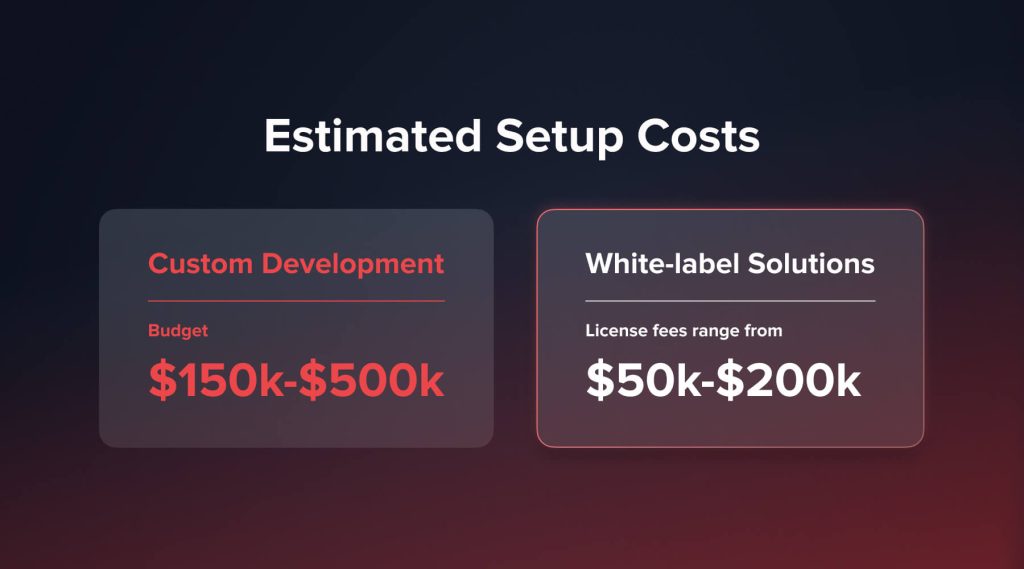
Estimated Setup Costs
Costs will vary depending on your specific requirements, but here are some general guidelines:
- White-label Solutions: Relying on turnkey exchange platforms saves development time but limits customization. License fees range from $50k-$200k.
- Custom Development: Building from scratch provides full control but requires 6-12 months and $150k-$500k depending on features and technologies used.
Additional costs include compliance, cybersecurity audits, marketing budgets, and ongoing infrastructure/support expenses.
Potential Revenue Streams
Once launched, exchanges make money primarily through trading activities:
- Trading Fees: Charging 0.1%-0.3% on all transactions is the biggest income generator for high-volume exchanges.
- Withdrawal Fees: Small charges of $1-5 apply when withdrawing funds to cover processing.
- Listing Fees: New cryptocurrencies pay substantial listing fees, sometimes monthly after that.
- Margin Trading: Earning interest on loans for leveraged traders is common.
- Premium Accounts: Advanced tools attract monthly subscriptions.
- Data APIs: Monetizing real-time market data sees fees from institutions.
With millions in daily trading globally, even modestly successful exchanges can achieve profitability within 1-2 years to recoup setup costs. Ongoing growth and innovation expand income streams further. Understanding costs versus potential revenues is key for planning strategy and fundraising initiatives.
What Technology Stack Should You Use?
The technology framework powering your cryptocurrency exchange significantly impacts its performance, functionality, scalability, and security. The technology stack includes programming languages such as Java, PHP, and Swift, databases like MongoDB and MySQL, cloud services from AWS or Google Cloud Platform, and APIs from popular exchanges like Binance and Coinbase. Careful selection and implementation of the tech stack are paramount for success.
- Frontend
Popular front-end frameworks include React, Angular, and Vue.js for building responsive trading interfaces on the web and mobile.
- Backend
For APIs and services, efficient options are Node.js, Python, Java, C#, and Go, depending on developer expertise.
- Databases
Non-relational databases like MongoDB are best suited for high-volume unstructured trade data. Consider PostgreSQL, MySQL, or ClickHouse for additional relational data.
- Infrastructure
Cloud providers AWS, Google Cloud, and Microsoft Azure offer scalable serverless architectures optimized for cryptocurrency workloads.
- Blockchains
Integration with public networks like Ethereum, Binance Smart Chain, Solana, etc. uses node infrastructure. WebSocket APIs stream real-time prices.
- Libraries & Integrations
Pre-built solutions speed developments, such as CoinGecko for pricing data, Coinpayments for fiat gateways, and Auth0 for authentication.
- Security
Cold wallets, multi-signature setups, regular audits, encryption, threat modeling, and penetration testing ensure robust defenses.
- Testing
Thorough testing using tools like Jest, Cypress, and Cucumber raises quality assurance standards before deployment.
Other Considerations for Your Crypto Exchange Business
In addition to developing the technical platform, there are several other important business components to consider:
- Legal: Take your time to ensure ongoing compliance with regulations as the market evolves. Register necessary business entities and maintain accurate records.
- Marketing: Develop long-term marketing strategies beyond launch promotions. Advertise new coin listings, events, tutorials, and more on an ongoing basis.
- Sales: Build sales processes for attracting new clients and converting users to paying subscribers over time. Offer premium features, subscriptions, or enterprise solutions.
- Finance: Create accounting practices, budgets, and forecasting models. Manage balance sheets, cash flow, and exchanges between fiat and cryptocurrencies effectively.
- Operations: Establish procedures for customer support, site monitoring, risk management, and security. Continuously audit systems and conduct penetration testing.
- Liquidity: Source sufficient liquidity from third-party providers or become a liquidity provider yourself. Ensure ample order-matching capabilities to avoid lags or downtime during high volatility periods.
Conclusion
This concludes our overview of establishing a cryptocurrency exchange. The process entails thorough planning and execution across technical, operational, and business dimensions. It is challenging, but with the appropriate blueprint, any dedicated entrepreneur or team can translate their vision into reality.
For those committed to taking the next steps, be sure to revisit this material frequently for reference purposes, leverage other available resources, and reach out with any additional questions as needs arise. With diligent work, exchanges established from the ground up can achieve high performance on par with the prominent names currently leading the field.
